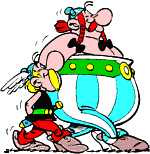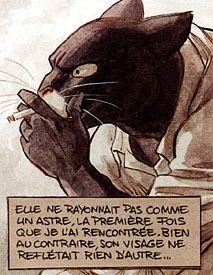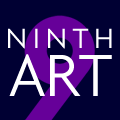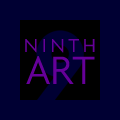>> Top Nine: Wheeler's Choice
>> Comment: 'San Diego', To The Tune Of 'Desperado'
More...

NOT THE NINTH ART NEWS
If you haven't been to the Ninth Art message board at Delphi lately, it's time to check in. Our Previews columnist Chris Ekman has added a new string to his bow as Ninth Art's very own newshound.
Ninth Art isn't a comics news site, but that doesn't mean we can't provide a newswire service for our readers. So Chris is browsing the various news resources and sifting through the press releases on your behalf and posting highlights and links to the board.
Of course, this being Ninth Art, you don't get the news without a touch of commentary. Chris isn't shy of sharing his own views on the breaking stories, and hopefully you won't be either. Pop in to the message board to offer up your two cents.
RAMA-LAMA-DING-DONG
One of the most popular news sources out there is, of course, Newsarama, a standard-bearer for the dissemination of high quality comics hype. Founding father Michael Doran bid his farewell to the site earlier this week to take on the mantle of Mighty Marvel Hullabalooer. Said Doran, "The best part of joining Marvel is that I get to keep doing the same thing: spreading the word about Marvel Comics while working even more closely with the press community I've enjoyed being a part of so much."
Congratulations, Michael. Oh, and excelsior!
A BANDE APART
When my colleagues and I decided to call this site Ninth Art, the idea behind the name was to bring a European sensibility to the world of Anglophone comics. And when I say 'European sensibility', I suppose what I mean is, appreciation without prejudice. The claim that comics are the ninth art comes from France, where no-one doubts that the medium is capable of adult, intelligent and challenging storytelling.
Even American comics are treated with greater deference in France than they are in their home market. While superhero comics are still all too rare a site at UK newsagents and US newsstands, dozens of fat little collections of translated American comics are a snap to find in French stores. It isn't just Marvel stuff, either, but DC, Wildstorm, Cliffhanger, CrossGen - all racked alongside the magazines and newspapers.
It was during a trip to Poitiers that I noticed how commonplace these American comics are in France - but they weren't hogging all the shelf space. There was plenty of domestic product, too, usually presented in a format that isn't widely recognised in the US.

Books like TINTIN and ASTERIX are just the tip of the iceberg when it comes to France's album-format books. These albums are large-scale hardback books that retail for around ten euros each (that's about ten dollars, or six pounds). The format has become a little more familiar to US readers of late, largely due to publishers like Humanoids that have opted to print English-language versions of their books.
Humanoids' output is dominated by science fiction works, like THE INCAL and FROM CLOUD 99, but the range on offer in French newsagents is much broader than that. Erotic comics are sold right next to cartoon books. Historical epics jostle for space alongside sword-and-sorcery fantasies. There was even a book called SODA - the cartoonish tale of a cop who dresses as a priest and takes on some kind of Vatican mafia - that I decided to pick up despite the fact that my French is pretty much limited to, 'What is the way to the train station?'
I recently followed up that purchase with another book I couldn't read; BLACKSAD, by Spaniards Juan Diaz Canales and Juanjo Guarnido. It's a crime noir with all the classic ingredients - a grizzled detective, a dead girl, a battered old boxer, a slick assassin, an indignant police chief - but all the characters are anthropomorphic animals. The lead character is a humanoid black cat.
 And if that idea sends you scrabbling for cover, let me tell you this: BLACKSAD is one of the most beautiful comics I've ever seen. Though the characters have a slight Disney feel (the creators once worked at the animation studio), every page is lovingly illustrated and gorgeously painted. It's both more seedy and more lavish than anything to come from the House of Mouse.
And if that idea sends you scrabbling for cover, let me tell you this: BLACKSAD is one of the most beautiful comics I've ever seen. Though the characters have a slight Disney feel (the creators once worked at the animation studio), every page is lovingly illustrated and gorgeously painted. It's both more seedy and more lavish than anything to come from the House of Mouse.
Neither SODA nor BLACKSAD is currently available in the Anglophone market, but that could change as more American publishers move to tap in to this rich back-catalogue of top drawer comics.
Humanoids has actually fallen into something of a rut these days with much of its weight gone to Americanising the Moebius and Jodorowsky space operas. (If you're going to get stuck in a rut, though, that's the rut to get stuck in.) Dark Horse launched its Venture unit a little over a year ago, which publishes European comics by the likes of Hermann and Franco Saudelli, as well as many excellent works by Argentinean creators.
And then there's NBM, which is really leading the charge in this field, with translations of works by such Continental masters as Milo Manara, Vittorio Giardino and Jacques Tardi. These are the creators - and these are the comics - that demonstrate how it is Europe came to treat comics so seriously. These are the works that demonstrate clearly and profoundly how magnificent an art form comics can be.
These are the ninth art.
QUEERING THE PITCH
Ever since my call out to the industry for a greater representation of homosexuals in comics, things have been shifting.
Not that I plan to take all the credit for that, of course. Most of those responsible have long shown positive attitudes towards alternative lifestyles. Peter Milligan may have given us 'celebrity gay' in X-STATIX, but he also bought us one of the few great extended explorations of sexuality in comics form, ENIGMA. In fact, he's almost always put gay characters in his comics. Even his abortive run on ELEKTRA had a gay sensei.
Similarly, Peter David - who recently gave us some interesting alternatives in CAPTAIN MARVEL, confirming the titular hero's involvement with a gender-shifter, and untapping the Sapphic inclinations of his female lead - also gave us gay supersoldier Hector in his HULK run.
 Mark Millar's implicitly gay Colossus in ULTIMATE X-MEN is no surprise coming from a writer whose approach to The Midnighter and Apollo in THE AUTHORITY was so unapologetic that it probably offended more gay people than straight. (Personally, I never had a problem with it.)
Mark Millar's implicitly gay Colossus in ULTIMATE X-MEN is no surprise coming from a writer whose approach to The Midnighter and Apollo in THE AUTHORITY was so unapologetic that it probably offended more gay people than straight. (Personally, I never had a problem with it.)
No-one's the least bit surprised to see gay characters in Alan Moore's comics, of course, and with Grant Morrison's work it's actually more surprising that he doesn't have a gay X-Man (hey, Chuck Austen's got one!) - unless you believe Beast really has become king of the swingers. And while gay characters are nothing new to Vertigo, the inclusion of a gay lead in former ongoing series CODENAME: KNOCKOUT might still have seemed unusual, if it hadn't been a gay author (Robert Rodi) writing it.
There was little controversy when a gay character was first added to the cast of GREEN LANTERN, because although it was Ron Marz's idea, it was PEDRO & ME's Judd Winick who was left with the execution, and the book falls under the oversight of openly bisexual editor Bob Schreck. Far more controversial was the recent gay-bashing story, even though the abuse of supporting cast members is an old superhero staple.
The attitudes of these writers haven't changed, but something has. There certainly seems to be more gay characters around today than there have ever been before in mainstream comics. What's more, they're openly gay. They're using the word. They're kissing. Some are even treating it as a non-issue. Gay characters have shrugged off the question mark and are becoming normal and mundane.
So what did change?
I think it was the audience. There's a lot of intolerance out there still, but homosexuality is less of a stigma every day. Comic book editors and publishers seem to be aware of that, and more importantly, they've realised that being in the thrall of idiots doesn't do the industry any favours. The inclusion of alternative sexualities in superhero comics may even be a measure of the industry's desire to be seen as an intelligent medium, deserving of serious treatment.
Things are changing. A big muscular man in tights can now be gay. That's progress.
ALONG FOR THE RIDE
The other day I received an uncorrected proof of THE RIDE TOGETHER, by Judy and Paul Karasik. The book is half prose, half comic, with book editor Judy providing the former, and cartoonist and former RAW associate editor Paul providing the latter. Judy and Paul are siblings, and THE RIDE TOGETHER is their touching family memoir about their experiences living with an autistic elder brother.
It's a wonderful read for two reasons. Firstly, both authors weave their highly personal tales with an accomplished and affectionate touch, drawing the reader in to an intimate appreciation of what autism really means. Secondly, it's a fascinating look at the ways in which prose and comics work to tell the same story, with similar or related scenes played out in the two media. Interspersed with one another, Judy Karasik's narrative becomes a voice-over, a story the reader receives, while Paul Karasik's narrative immerses you in the experience. Each account is detailed, but the different emphasis that each author takes makes for an especially vivid tale.
THE RIDE TOGETHER, published by Simon & Schuster's Washington Square Press 'Pocket Books' division, should hit stores in January. Keep an eye out for it, and stay tuned for a longer review here at Ninth Art at a later date.

This article is Ideological Freeware. The author grants permission for its reproduction and redistribution by private individuals on condition that the author and source of the article are clearly shown, no charge is made, and the whole article is reproduced intact, including this notice.


